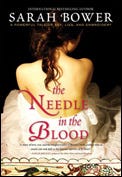In The Needle in the Blood, Sarah Bower imagines how the Bayeux Tapestry may have been created, but the Tapestry serves more as setting and symbol than as central purpose. This sophisticated novel is about love, ambition, fury, forgiveness, misunderstanding and again and always, love.
Gytha is a serving woman to Edith, King Harold of England's common-law wife. As the novel opens on October 14, 1066, Harold is dead, butchered in the Battle of Hastings. William the Conqueror's half brother Odo, the Bishop of Bayeux, refuses to deliver the dead king's body to Edith and Harold's mother for burial. A few days later, as Gytha watches Edith and her court ladies carted away like criminals, she believes she has lost everything. But within her talent for embroidery lie the seeds of a new life.
Odo decides to commemorate the Norman victory with an embroidered wall hanging. His sister scours the ravaged country for women with the skill to create it. For those chosen, it is a strange and bitter project. Gytha says, "I refuse to sew lies." But she sees this as a chance to get close enough to Odo to kill him. Keeping either of her resolves proves a slippery undertaking.
The bishop's formidable charm is less of a stumbling block than his innate, if incomplete, integrity: "'You have made Bayeux very pretty,' he remarks, an edge to his voice which makes it sound as though the prettification of Bayeux is some kind of misdemeanour. 'Quite a fairy city.'"
The Needle in the Blood is a love story, but Bower takes her time with it, developing her characters with depth, insight and compassion before thrusting them into the predicament of a forbidden love affair. Along the way, she slips in imaginative possibilities for how and why various features of the Tapestry came to be, but these never dominate the story. That is for her characters, as Bower reaches for a more timeless truth than the merely factual. (2007, 576 pages, including a brief Afterword explaining where the story departs from the historical record)




